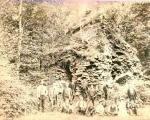![header=[Marker Text] body=[First furnace west of the Alleghenies. Built 1789 on banks of nearby Jacob's Creek, its ruins are still observable. Supplied iron for Wayne's campaign in 1794 against the Indians. ] sign](kora/files/1/10/1-A-249-139-ExplorePAHistory-a0h6y6-a_450.jpg)
Mouse over for marker text
Name:
Alliance Furnace [Steel]
Region:
Laurel Highlands/Southern Alleghenies
County:
Fayette
Marker Location:
SR 1002, about 6 miles NW of PA 819, Perryopolis and PA 819, 1 mile N of Dawson
Dedication Date:
November 22, 1946
Behind the Marker
"When I came to my appointment this whole country appeared as a howling wilderness. Settlements were quite thin, quite remote from one another in many parts, and little cultivated. In many places the living, manners, state of society and morals of the people seemed to correspond." So recalled Rev. Thornton Fleming, a Methodist minister sent to the upper Monongahela valley in the 1790s.
Settlers eked out a living on the poor soil, sending downstream as far as New Orleans such varied products as flour, cider, bacon, peach brandy, pottery, cabinetry - and whiskey. Fayette County was a stronghold in the Whiskey Rebellion of 1794, when the U.S. army marched in against backcountry distillers. This "howling wilderness" also possessed the iron ore and coal deposits, little noticed at the time, that spawned the great Pennsylvania iron and steel industry.
The Alliance Ironworks erected the first blast furnace west of the Allegheny-Appalachian mountain range. It first made raw iron on November 1, 1790. The Alliance's Philadelphia partnership also built a forge for working the iron into useful shapes. The area's accessible iron ore deposits and plentiful trees, for charcoal, soon attracted several other furnaces and forges: the Union furnace on Dunbar Creek (4 miles south of Connellsville); a forge and furnace along George's Creek (south of Uniontown); Plumsock Forge in Menallen Township; and the Laurel furnace on the Youghiogheny.
These early ironworks hauled their castings and forge products twenty miles or more to the port at Brownville. From here, goods were shipped by flatboats to Pittsburgh or further down the Ohio River to frontier settlements. Trade was by barter. One furnaceman recalled that he conducted business for three years straight and saw only ten dollars in money.
Pittsburgh or further down the Ohio River to frontier settlements. Trade was by barter. One furnaceman recalled that he conducted business for three years straight and saw only ten dollars in money.
Fayette County's nineteen blast furnaces, built mostly before 1815, literally burned up the forests they depended on. By 1837 only nine blast furnaces remained, each making around 500 tons of pig iron each year. Ample fuel was the problem. Each ton of pig iron required a minimum of 90 bushels of charcoal. One estimate had it that the nine furnaces in 1837 required the timber of nearly 12,000 acres of forest, or about eighteen square miles.
Only four blast furnaces survived into the 1850s. Amazingly enough, ironmakers at the time failed to exploit the region's outcroppings of coal. When baked in coke ovens, Connellsville coal made the world-famous coke that created the fortunes of
coke ovens, Connellsville coal made the world-famous coke that created the fortunes of  Henry Clay Frick and numerous others. Connellsville coke literally fueled Pittsburgh's iron and steel industry.
Henry Clay Frick and numerous others. Connellsville coke literally fueled Pittsburgh's iron and steel industry.
Settlers eked out a living on the poor soil, sending downstream as far as New Orleans such varied products as flour, cider, bacon, peach brandy, pottery, cabinetry - and whiskey. Fayette County was a stronghold in the Whiskey Rebellion of 1794, when the U.S. army marched in against backcountry distillers. This "howling wilderness" also possessed the iron ore and coal deposits, little noticed at the time, that spawned the great Pennsylvania iron and steel industry.
The Alliance Ironworks erected the first blast furnace west of the Allegheny-Appalachian mountain range. It first made raw iron on November 1, 1790. The Alliance's Philadelphia partnership also built a forge for working the iron into useful shapes. The area's accessible iron ore deposits and plentiful trees, for charcoal, soon attracted several other furnaces and forges: the Union furnace on Dunbar Creek (4 miles south of Connellsville); a forge and furnace along George's Creek (south of Uniontown); Plumsock Forge in Menallen Township; and the Laurel furnace on the Youghiogheny.
These early ironworks hauled their castings and forge products twenty miles or more to the port at Brownville. From here, goods were shipped by flatboats to
Fayette County's nineteen blast furnaces, built mostly before 1815, literally burned up the forests they depended on. By 1837 only nine blast furnaces remained, each making around 500 tons of pig iron each year. Ample fuel was the problem. Each ton of pig iron required a minimum of 90 bushels of charcoal. One estimate had it that the nine furnaces in 1837 required the timber of nearly 12,000 acres of forest, or about eighteen square miles.
Only four blast furnaces survived into the 1850s. Amazingly enough, ironmakers at the time failed to exploit the region's outcroppings of coal. When baked in





